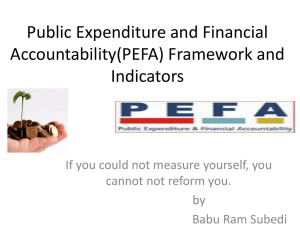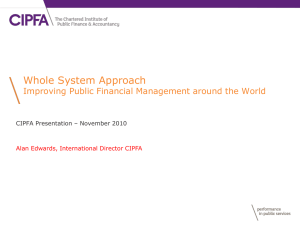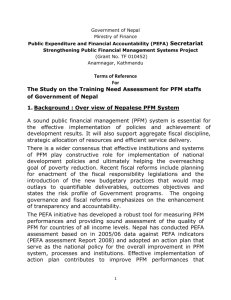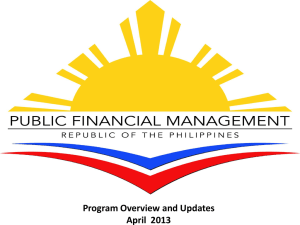Presentation Local PFM (complete)
advertisement
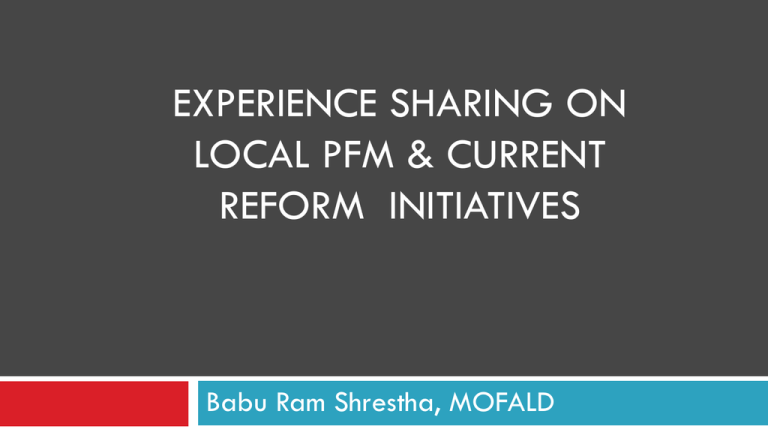
EXPERIENCE SHARING ON LOCAL PFM & CURRENT REFORM INITIATIVES Babu Ram Shrestha, MOFALD Assessment of Nepal’s Public Financial Management System (PFM) Nepal’s PFM at the national level. Nepal’s PFM at the sub-national level. Current reform initiatives in local PFM Nepal’s PFM at the national level. The Government’s PFM Initiatives. To address PFM issues, the government developed a Public Financial Management Reform Program (PFMRP) for 2010-2013 Nepal’s PFM at the sub-national level. The Government’s local government program and subnational PFM issues The government’s Local Government and Community Development Program (LGCDP, 2008-2014) has at the forefront of local governance reforms. In the course of LGCDP implementation, there were occasional reports of fiduciary risks and compliance issues. FIDUCIARY RISK ANALYSIS (FRA) ADB and its development partners conducted a Fiduciary Risk Assessment (FRA) of LGCDP. Donors subsequently financed a Public Expenditure Tracking Survey (PETS) of LGCDP. The FRA highlighted cases of lack of transparency in grant allocation, Undue interference by political parties, Poor accounting and reporting, Non-compliance with procurement regulations, and Lack of internal and external audit. Fiduciary risks were identified such as Poor compliance with participatory processes, Diversion of resources, Abuse of authority in decision-making, Poor design and budgeting, Delays in budget releases, Poor revenue management, Weak procurement systems, Poor internal controls, and weak oversight. Categorizing the issues Budget and fiscal management issues at the local level. Fiduciary risk at the sub national level Public procurement problems. Governance problems. The new PFM and Fiduciary Risk Reduction Action Plan (FRRAP) In response to the above assessments of LGCDP, the Ministry of Federal Affairs and Local Development (MOFALD) in March 2012 approved a Fiduciary Risk Reduction Action Plan (FRRAP). The plan reflects lessons learned from LGCDP implementation, notably importance of strengthening PFM systems and Capacity building in PFM at the local level, and the value of demand-side mechanisms. Purpose and Objectives of the Plan The purpose of the PFM & FRRAP is to identify the tasks and activities involved in addressing essential PFM reform initiatives and mitigating and minimising the fiduciary risks in LBs’ operations with the following objectives: • • • Aggregate fiscal discipline Strategic allocation of resources Efficient use of resources for service delivery Introduction to the Plan This PFM & Fiduciary Risk Reduction Action Plan (FRRAP) integrates the many PFM and related fiduciary risks into a comprehensive action plan. The action plan includes the tasks, priorities, timings, resource estimates, responsibilities, management controls, reporting procedures, as well as risks to the plan itself. PFM cycle and key fiduciary risk Areas Planning programming and budgeting Funds flow, including budget release Implementation, including procurement management Internal accountability External auditing, reporting and monitoring and evaluation, and Revenue management Strategies Strengthen participatory planning process Improve accounting and reporting systems Promote transparency, Enhance capacity Mitigate perceived risks Strengthen civic oversight PEFA FRRAP will mainly be executed through local bodies Expected results Improved planning programming and budgeting Improved funds flow, Improved implementation, Improved internal accountability Improved auditing and monitoring & evaluation, and Improved revenue management Fiduciary risk rating matrix for LBs LBs comprise all 75 DDCs, 58 Municipalities and 3,915 VDCs. This action plan categorizes risks rating into low (L), medium (M), and high (H). Low risk - Represents a situation where there is basic compliance with existing rules of LBs of Nepal, although coverage may not be 100% Medium Risk - Indicates there are some significant weaknesses in compliance or that procedures need to be changed High Risk - Indicates substantial failure to comply or that the system will require substantial upgrading to meet the standard Classifying fiduciary risks in LBs Fiduciary risks in local bodies have been classified into process, result and corruption related risks Process Risk Fiduciary Risk Result Risk Corruption Risk Reform cycle Implement PFM reforms Local PEFA Assessment Formulate PFM reform program PFM-FRRAP Identify main PFM Identify main weaknesses PFM weaknesses Recommend Recommend PFM reform PFM reform measures measures Investigate underlying causes Reform initiatives Strengthening Public Management Program (SPMP) 2012/13-2014/15 supported by ADB, implementation under LGCDP-II Reform budget, fiscal and fiduciary risk management at the sub national or local government level DDCs, Municipalities and VDCs Public procurement and Oversight and accountability institutions Current reform initiatives in Local PFM Budget and fiscal management Fiduciary Risk management at the sub- national level (FRRAP) Public procurement reforms Oversight and accountability capacity building Objectives of reform initiatives Budget and fiscal management Objective: To promote fiscal sustainability and more predictable and timely fiscal transfers to the local governments through improved budget and expenditure management Fiduciary Risk management at the sub- national level Objective – To promote transparency and accountability of public expenditures of local governments. Public procurement reforms Objective: To promote economy and efficiency and reduce fiduciary risks in public spending at the national and local level. Oversight and accountability capacity building Objective – To help prevent and reduce corruption in public institutions by strengthening the capacity of anti-corruption and accountability institutions. Components of SPMP reform program supported by ADB at the National & sub national level Component 1 Local government budget and fiscal management 7 MILLION $ COMPONENTS OF SPMP Component 3 Public procurement reform 3 MILLION $ 30 MILLION $ Component 2 Component 4 Fiduciary risk management at the local government level 18 MILLION $ Oversight and accountability capacity building 2 MILLION $ Component wise activities Local government budget and fiscal management Enforcement of blended block-grant guidelines and prescribed timelines to improve fiscal transfers; introduction of results-based management for DDCs and municipalities; Strengthening local accounting systems, including use of IT tools to automate transactions; Enhancing local resource mobilization and fiscal sustainability, including the development and pilot implementation of a Municipal Administration and Revenue System (MARS); and Support for drafting a Fiscal Responsibility Bill. Fiduciary risk management at the local government level Promotion of public auditing by Ward Citizen Forums and Citizen Awareness Centers; Strengthening external and internal audits of local bodies, including application of risk-based internal audits of village development committees (VDCs) by DDCs; Capacity-building on auditing and resultsbased reporting of local bodies; and Follow-on subnational PEFA survey and PETS of LGCDP. Public procurement reform Institutional, legal and regulatory reforms to strengthen public procurement; Development and implementation of eGovernment Procurement (e-GP); improved procurement management at national and local levels, including developing local bodies’ procurement plans, drafting standard bidding documents, etc; and Capacity development of PPMO and key staff at central and local levels. Oversight and accountability capacity building Legal and regulatory reforms to elevate Nepal’s anti-corruption regime per its commitment to the U.N. Convention against Corruption (UNCAC); Human resource development of the National Vigilance Center (NVC); Implementation of Corruption Vulnerability Diagnostics of select ministries; and Social audits of select local bodies. Stay in touch Babu Ram Shrestha email: brshresth@gmail.com Cell no. 98511 92 992 THANKS FOR YOUR KIND ATTENTION
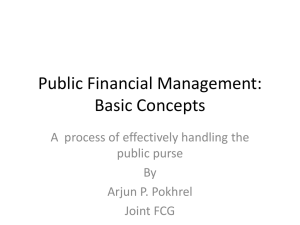
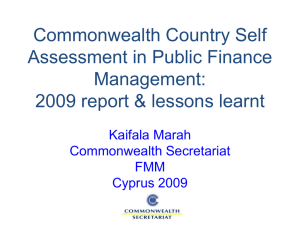

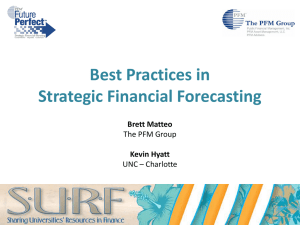
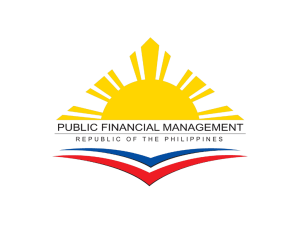
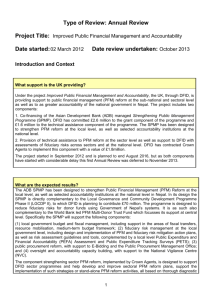
![Mark Whitenack Digital Assets PowerPoint Presentation []](http://s2.studylib.net/store/data/005383425_1-9cf830a5f2e9fc777daa963eb9460c8e-300x300.png)
